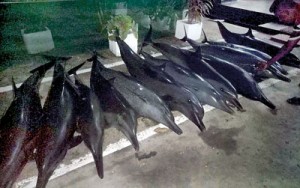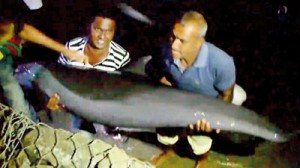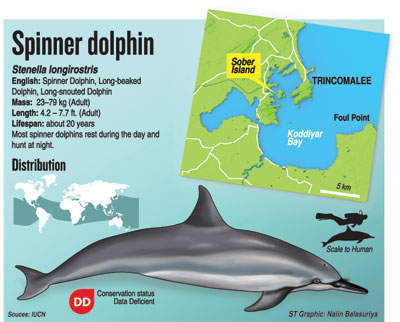News
Fishermen playing deadly games with dolphins

A video captured by an onlooker shows some of the dolphins being hauled in while alive
Deaths of a dozen dolphins trapped in a beach seine net (ma dela) last Wednesday evening in Trincomalee has stirred strong emotions.
A video captured by an onlooker shows some of the dolphins being hauled in while alive, contesting claims by fishermen that they had released some.
Nine Trincomalee fishermen who were arrested were denied bail and are in remand custody.
All marine mammals in Sri Lanka are protected under the Flora and Fauna Ordinance, and Fisheries Act. The fishermen were arrested under the provisions of these laws, said Roshan Aluthgamage, the OIC of Trincomalee Harbour.
The dolphins had been caught near the inner harbour. The fishermen who had come from nearby Manayaweli village started laying the net around 4 pm and it was dark around 7pm when they pulled the net in. According to the fishermen, they realized dolphins were in the net but that it was too late.
Beach seine nets are known as ‘ma dela’ in Sinhala. It is a fishing net laid from the shore and is a traditional fishing method, which is legal. The fishermen also had a license and it is also possible that they did not target the dolphins. But as it is a crime to kill the protected marine mammal, they were arrested, Aluthgamage said.
Marine mammal expert Ranil Nanayakkara, identified the victims as spinner dolphins (stenella longirostris), the most acrobatic of all dolphins.
In 2013, the killing of 40 dolphins as a result of an illegal purse seine net, called the ‘laila net’ in Kalpitiya, highlighted the need to look at fishing practices around Sri Lanka.

Laid out: The dead dolphins. Pic by Rahul Samantha
There are suspicions that hundreds of dolphins are getting killed in fishing nets.
As it is illegal to kill a dolphin or possess its flesh, Sri Lankan fishermen also tie their tails to sand bags and sink the carcasses, say marine activist Upali Mallikarachchi.
Often the flesh is used as bait, he said.
There are occasions when fishermen target dolphins. Two fishermen in Mirissa were arrested last year in the possession of a dolphin thay had harpooned, according to news reports.
Senior Lecturer of the Department of Oceanography and Marine Geology University of Ruhuna, Dr Terney Pradeep Kumara, said dolphins alive are more worth than dead pointing out the benefits from the whale and dolphin watching industry. The worldwide whale and dolphin tourism industry was estimated to be worth US$2 billion in 2010. he said Sri Lanka stands to lose a good opportunity.
Travice Ondaatjie, the Conservation Officer of the Sri Lanka Sub Aqua Club, said that killings in Trincomalee show the need for more effective monitoring by the Ministry of Fisheries and law enforcement. A few years back many more dolphin were killed in Kalpitiya, too. But were the perpetrators punished? he asks.
Dr Pradeep Kumara, general manager of the Marine Environment Protection Authority, urged greater cooperation among government agencies. He suggests a coordinating framework involving the Department of Wildlife Conservation, Department of Fisheries, National Aquatic Resources Research and Development Agency, Central Environment Authority, and even the Forest Department as they manage some of the mangroves, to protect marine resources.


